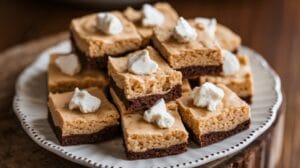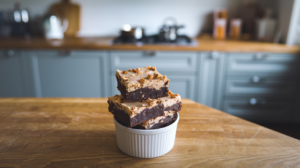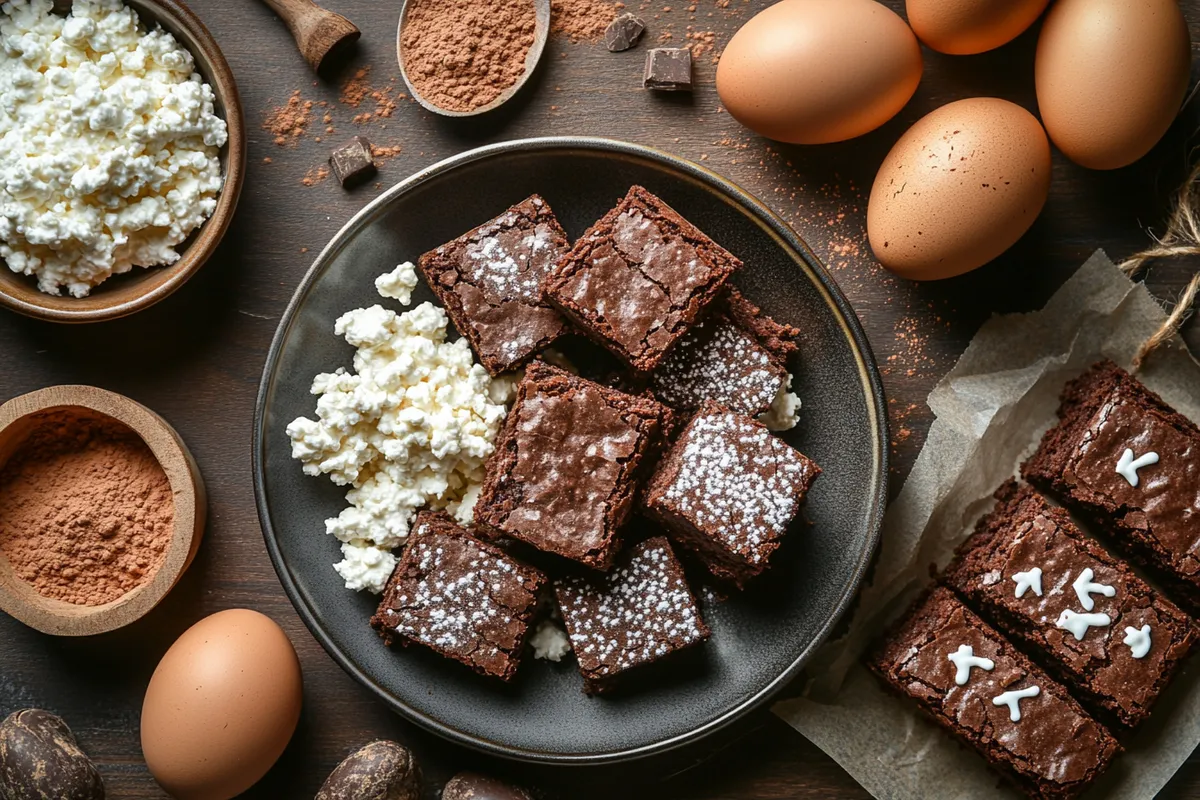Discover how cottage cheese brownies deliver creamy texture, rich flavor, and added protein, plus tips, recipes, and FAQs to perfect your baking.
Understanding Cottage Cheese Brownies
Are you curious about a new twist on classic brownies? Cottage cheese brownies merge rich chocolate flavor with creamy, protein-packed cottage cheese. This combination appeals to health-conscious dessert lovers who seek sweet treats with a nutritional edge. These brownies maintain a fudgy texture, yet contain more protein than standard recipes. Consequently, many home bakers and professionals now embrace cottage cheese as a unique ingredient. Eventually, you’ll discover that these brownies prove nutritious indulgences can taste phenomenal.
The Rising Popularity of Cottage Cheese Brownies
Cottage cheese recently gained popularity in desserts because it adds creaminess without excess butter or cream. Furthermore, incorporating cottage cheese into brownies offers a balanced, protein-enriched treat. Consequently, these brownies attract those who want sweets without sacrificing nutrition.
How Cottage Cheese Brownies Differ from Traditional Brownies
Standard brownies rely heavily on butter and sugar. Conversely, cottage cheese brownies reduce fat while boosting protein. Moreover, the curds blend smoothly into the batter, creating a tender crumb. Ultimately, this adaptation results in a lighter treat that still satisfies chocolate cravings.
Why Bake with Cottage Cheese?
Cottage cheese infuses desserts with several benefits. Initially, it contributes valuable protein and essential nutrients. Accordingly, this addition supports a more balanced snack or dessert, appealing to those who track macros or maintain active lifestyles. Furthermore, cottage cheese ensures a moist, creamy texture that enhances the overall eating experience. Instead of compromising flavor, it enriches the final product, adding subtle tang and moisture. Another advantage involves appealing to various diets. Those seeking healthier dessert alternatives find cottage cheese brownies ideal. Eventually, baking with cottage cheese proves that indulgence and nutrition can coexist. Indeed, it encourages creativity in baking, opening doors to unique flavor combinations and reimagined classics.
Protein and Nutrient Boost in Cottage Cheese Brownies
Cottage cheese provides high-quality protein, calcium, and B vitamins. Consequently, these brownies support muscle recovery and bone health. In addition, the added protein helps manage hunger, making each serving more satisfying.
Achieving Moisture and Creaminess
Cottage cheese’s natural moisture keeps brownies tender. Blending it ensures no visible curds remain. Therefore, the resulting texture feels rich and smooth, satisfying even picky eaters.
Supporting Health-Conscious Dessert Choices
By incorporating cottage cheese, you craft brownies that fit a healthier lifestyle without sacrificing taste, appealing to mindful dessert lovers.
Cottage Cheese Brownies: The Chemistry of Flavors and Textures
Crafting cottage cheese brownies involves understanding food science. Cocoa’s bitterness balances with sugar’s sweetness, while cottage cheese adds creamy moisture. Proteins within cottage cheese influence brownie structure. They help set the batter as it bakes, resulting in a slightly firmer, yet still fudgy interior. Meanwhile, dairy fats carry flavor and deliver richness, ensuring each bite pleases the palate. This harmonious balance emerges through careful ingredient ratios. Consequently, cottage cheese brownies demonstrate that subtle changes in ingredients can transform a familiar dessert into something innovative and satisfying.
Role of Dairy Proteins in Cottage Cheese Brownies
Dairy proteins contribute structure and tenderness. While brownies don’t rely on gluten like cakes, these proteins help create a stable, moist crumb. Therefore, cottage cheese proteins improve texture, enhancing chewiness without making brownies dry or crumbly.
Balancing Acidity and Sweetness
Cottage cheese’s slight tang offsets sugar, preventing cloying sweetness. This balance results in a more complex flavor profile. Additionally, a hint of acidity brightens the chocolate taste, ensuring the brownies remain rich but never one-dimensional.
Incorporating Cottage Cheese into Brownie Batters
Integrating cottage cheese into brownie batter requires attention. Initially, it’s best to blend cottage cheese until smooth. This ensures no lumps remain. Next, combine it with melted chocolate, cocoa powder, and other liquids before folding in dry ingredients. Avoid overmixing to maintain tenderness. If using electric mixers, choose a low speed. Consequently, the finished batter looks glossy and thick, similar to traditional brownies. By handling cottage cheese gently and blending thoroughly, bakers achieve a uniform texture. Eventually, these steps guarantee a seamless fusion of flavors and a brownie that rivals classic versions.
How Blending Cottage Cheese Affects Texture
Blending cottage cheese creates a velvety mixture. This step prevents gritty pockets and ensures even distribution. As a result, the brownies emerge from the oven with a uniform crumb, satisfying those who value consistency and smoothness.
Techniques to Ensure Smooth Integration
To integrate cottage cheese seamlessly, strain it if watery. Then blend with a hand blender or food processor until creamy. Incorporate gradually, whisking carefully. Consequently, these methods result in a cohesive batter that bakes evenly.

Nutritional Profile of Cottage Cheese Brownies
Compared to regular brownies, cottage cheese brownies often boast a healthier nutrient balance. They contain more protein and sometimes less fat, depending on chosen ingredients. This improved profile supports stable energy levels and long-term satisfaction. Moreover, cocoa adds antioxidants, and if using whole-grain flours or natural sweeteners, fiber increases. Altogether, cottage cheese brownies deliver a guilt-reduced indulgence. While not a diet food, they represent a smarter dessert choice. Ultimately, these brownies help bridge the gap between health goals and sweet cravings, making them appealing to a wide range of eaters.
Protein, Calcium, and Micronutrients
Cottage cheese contributes calcium and protein, essential for bone and muscle support. These micronutrients complement the antioxidants in cocoa. Consequently, each bite offers more than just empty calories.
Comparing Macros to Regular Brownies
Regular brownies rely on butter and sugar. Conversely, cottage cheese brownies may include less saturated fat and more protein. This shift helps reduce calorie density and supports balanced eating patterns.
Choosing the Best Cottage Cheese
Selecting quality cottage cheese impacts flavor and texture. Low-fat varieties yield lighter brownies, while full-fat options produce richer results. For those sensitive to lactose, lactose-free cottage cheese works similarly. Plant-based alternatives made from soy or nuts also exist, offering similar creaminess. Whatever type you choose, ensure it’s fresh and mild-tasting. Avoid overly salty brands since saltiness may affect sweetness balance. Trying different cottage cheese options helps refine your ideal brownie formula. Eventually, you’ll discover which type produces the texture and taste you prefer.
Low-Fat vs. Full-Fat Options
Low-fat cottage cheese reduces calories and fat but might be slightly tangier. Full-fat versions impart creamier richness. Experiment to find which suits your palate and dietary needs.
Lactose-Free and Plant-Based Alternatives
For dietary restrictions, lactose-free or vegan-friendly cottage cheese substitutes maintain the recipe’s structure. These options ensure everyone, including vegans or lactose-intolerant individuals, can enjoy cottage cheese brownies.
High-Quality Cocoa and Chocolate
Chocolate quality affects brownie flavor. Choose unsweetened cocoa powder or high-quality chocolate bars with a higher cocoa percentage for deeper flavor. Dutch-processed cocoa offers smoother taste, while natural cocoa provides tangy notes. Selecting premium chocolate chips or chunks ensures intense chocolate goodness. Consequently, when paired with cottage cheese, these chocolate components shine. The creamy base allows cocoa’s complexity to emerge, resulting in brownies that exceed expectations. Investing in better chocolate leads to a dessert that delights your palate and rewards your efforts.
Types of Cocoa Powders
Natural cocoa tastes sharper, Dutch-processed cocoa tastes milder and darker. Either works, but adjustments in sugar may be needed. Taste test before finalizing the recipe.
Choosing Dark Chocolate Chunks or Chips
Higher cacao percentages yield richer chocolate flavors. Dark chocolate chunks add bittersweet depth, while semi-sweet chips keep it accessible. Pick what matches your sweetness preference.
Sweeteners and Flavor Enhancers
Sweetness sets the tone for brownies. Refined sugar is common, yet alternatives like honey, maple syrup, or stevia reduce processed sugars. Adding a pinch of salt sharpens chocolate notes. Vanilla extract enhances complexity, while a teaspoon of espresso powder intensifies richness. Cottage cheese brownies welcome subtle tweaks. Furthermore, these flavor enhancers help control sweetness and bitterness. By fine-tuning sweeteners and add-ins, you create a dessert that satisfies various preferences. Eventually, this flexibility ensures that cottage cheese brownies please everyone, from chocolate purists to adventurous bakers.
Natural Sweeteners and Honey
Honey or maple syrup adds moisture and subtle caramel notes. Adjust the quantity to maintain proper batter consistency. This approach reduces reliance on white sugar.
Adding Vanilla, Salt, or Coffee Powder
Vanilla softens bitterness, salt balances flavors, and a pinch of coffee powder accentuates chocolate depth. These small additions elevate brownies from ordinary to extraordinary.

Classic Cottage Cheese Brownies Recipe
A classic recipe provides a starting point for experimentation. Begin with quality cottage cheese, melted butter or oil, cocoa, sugar, eggs, and flour. Blend cottage cheese until creamy before folding it into the batter. Bake until just set, ensuring fudgy centers. The result? A decadent pan of brownies that marry indulgence and nourishment. This baseline lets you tweak sweetness, fat content, or flour type. Ultimately, these classic cottage cheese brownies remind you that dessert can taste incredible while offering improved nutritional value.
Basic Ingredient List for Cottage Cheese Brownies
- Cottage cheese (blended until smooth)
- Unsweetened cocoa powder
- Melted butter or oil
- Granulated sugar or alternative sweetener
- All-purpose or whole-grain flour
- Eggs or egg substitutes
- Vanilla extract, pinch of salt
Simple Steps for Perfect Cottage Cheese Brownies Results
- Blend cottage cheese until creamy.
- Mix wet ingredients, then add dry.
- Fold in cocoa and flour gently.
- Bake at the recommended temperature.
- Cool before slicing for best texture.
Healthier Twists on Cottage Cheese Brownies
Health-focused bakers can modify this recipe easily. Substitute whole-grain flours or almond flour for extra fiber and nutrients. Reduce sugar and add ripe mashed bananas or pureed dates for natural sweetness. Include fresh berries or chopped dried fruit for vitamins and flavor variation. With these adjustments, brownies become a nutrient-rich snack rather than a simple treat. Eventually, these tweaks help align dessert with personal health goals. Consequently, you enjoy sweets without feeling deprived.
Gluten-Free and Whole-Grain Options
Use gluten-free flour blends or oat flour for celiac-friendly brownies. Whole-wheat pastry flour also works, adding subtle nuttiness and more fiber.
Reducing Sugar and Adding Fruits
Cut back on refined sugar by introducing mashed bananas, applesauce, or pureed dates. These natural sweeteners lend moisture and mild sweetness, keeping brownies delicious and more nutritious.
Flavorful Add-Ins and Toppings
Beyond basic chocolate flavor, cottage cheese brownies invite creativity. Stir in chopped nuts like walnuts or almonds for crunch. Add pumpkin seeds or sunflower seeds for a savory twist. Dried cranberries or cherries introduce fruity tang. A swirl of almond butter, peanut butter, or cream cheese frosting transforms brownies into gourmet desserts. These extras improve texture and complexity. As a result, you can tailor brownies to any occasion, impressing guests or indulging your personal cravings. Experimentation ensures no two batches taste the same.
Nuts, Seeds, and Dried Fruits
Mix in chopped pecans, pistachios, or dried apricots. Each addition enhances contrast and creates layers of flavor, appealing to diverse palates.
Swirls of Nut Butter or Cream Cheese Frosting
Gently swirl nut butter or lightly sweetened cream cheese into the batter. This step adds visual appeal and creamy pockets, elevating brownies to bakery-level indulgence.
Cottage Cheese Brownies for Special Diets
Adapt these brownies for specific needs. For keto or low-carb, reduce sugar and use almond or coconut flour. High-protein versions involve extra whey powder. Vegan bakers replace eggs with flax “eggs” and dairy-free cottage cheese alternatives, ensuring everyone can enjoy these treats.
Keto, Low-Carb, or High-Protein Alternatives
Use erythritol or stevia for sweetness, almond flour instead of wheat. Add protein powder for muscle-building snacks.
Vegan-Friendly Adjustments
Opt for plant-based cottage cheese and flax eggs. Non-dairy chocolate ensures a 100% vegan dessert.
Cottage Cheese Brownies: Preparing the Perfect Batter
Crafting ideal batter involves proper mixing. Initially, whisk eggs and sugar until smooth. Then add blended cottage cheese and melted butter or oil. Sift cocoa and flour to avoid lumps. Fold them in gently, ensuring minimal gluten development. Achieving a glossy, thick batter indicates proper mixing. If too thick, add a splash of milk. Taste test sweetness before baking. Adjust flavors now, because afterward, changes become difficult. With practice, you’ll know the signs of a perfect batter. Eventually, these refined techniques yield brownies worthy of praise.
Proper Mixing and Whisking Methods
Whisk liquids first. Fold in dry ingredients carefully. Avoid overmixing to preserve tenderness. Gentle handling ensures a classic brownie texture.
Achieving the Right Consistency
Aim for a smooth, pourable batter that’s not runny. If overly thick, add milk. If too thin, a tablespoon of flour helps. Balance is key.
Baking Times and Temperature Control
Baking cottage cheese brownies correctly affects both flavor and mouthfeel. Preheat the oven and use a reliable thermometer. Most brownies bake between 325°F and 350°F. Keep a close eye on them because overbaking leads to dryness. Check them a few minutes before the recommended time. Brownies are done when edges firm up, yet the center remains slightly fudgy. Baking times vary depending on pan size, ingredient ratios, and personal preference. By mastering temperature and time, you achieve consistently delicious results.
Avoiding Overbaking Cottage Cheese Brownies
Remove brownies when the middle looks slightly underdone. They continue to set as they cool, ensuring moist, chewy centers.
Testing Doneness with Toothpicks
Insert a toothpick into the center. If it emerges with moist crumbs (not raw batter), brownies are ready. Wait too long, and they dry out.
Cooling, Cutting, and Storing
Allow brownies to cool completely before slicing. This waiting time improves texture and flavor, allowing cottage cheese and chocolate flavors to meld. For neat edges, run a sharp knife under warm water and wipe it clean between cuts. Store brownies in an airtight container. If refrigerated, they last several days. Freeze extras for longer storage, ensuring a healthy treat on demand. Proper handling keeps brownies fresh, preventing staleness. By respecting these steps, you preserve their creamy texture and sumptuous taste.
Letting Brownies Set for Best Texture
Cooling brownies on a wire rack helps them firm up. Patience ensures no crumbly slices or mushy centers.
Storing Cottage Cheese Brownies for Freshness
Seal them in airtight containers at room temperature for a few days. For longer shelf life, refrigerate or freeze. Thaw at room temperature before serving.
Cottage Cheese Brownies as a Dessert or Snack
These brownies fit multiple occasions. Serve them as a post-dinner treat or midday snack. Their protein profile suits busy individuals needing a quick energy boost. Pair them with Greek yogurt or fresh fruit to add nutrients and create a balanced mini-meal. Because they’re portable, pack brownies for work or school. Eventually, enjoying these brownies proves simple. Their familiar chocolate flavor appeals to everyone, ensuring no compromise between health and pleasure.
Pairing with Fresh Berries or Yogurt
Top warm brownies with juicy strawberries or raspberries. A dollop of vanilla yogurt provides creamy contrast, enhancing both flavor and nutrition.
Serving Warm vs. Chilled
Warm brownies taste rich and melty, while chilled brownies feel fudgier. Experiment with serving temperatures to discover personal favorites.

Beverages to Complement Cottage Cheese Brownies
Selecting the right drink enhances the tasting experience. Coffee pairs well, highlighting chocolate’s complexity. Herbal teas, like mint or chamomile, offer a soothing contrast. Non-dairy milks, such as almond or oat milk, provide creamy textures that complement brownies’ richness. Matcha lattes add earthy notes, while fruit-infused water keeps things light. Essentially, there’s no limit. Whether craving a bold espresso shot or a mild, caffeine-free tisane, choose a beverage that matches your mood. This thoughtful pairing elevates snacking to a delightful culinary moment.
Coffee, Tea, or Herbal Infusions
Rich espresso intensifies chocolate flavor. Light green tea refreshes the palate. Herbal blends calm the senses, ensuring dessert enjoyment without overwhelming taste buds.
Dairy-Free Milk Alternatives
Almond, soy, or oat milk add creaminess without dairy. They lighten the overall indulgence, appealing to lactose-intolerant and vegan eaters alike.
Presentation and Plating Ideas
Visual appeal matters. Cut brownies into uniform squares and place them on decorative plates. Sprinkle cocoa powder or drizzle melted chocolate on top. A few mint leaves or citrus zest lends brightness. Simple garnishes transform a humble brownie into a dessert centerpiece.
Garnishing with Mint Leaves or Citrus Zest
Mint leaves add freshness, while citrus zest provides subtle aroma. These touches impress guests effortlessly.
Using Decorative Plates and Stands
Elevate brownies on a cake stand or stylish plate. Presentation enhances the dessert’s appeal and enjoyment.
Cottage Cheese Brownies for Active Lifestyles
Active people often require protein for muscle recovery. Cottage cheese brownies supply protein and carbs, making them appealing post-workout treats. They help replenish energy stores and support recovery while satisfying chocolate cravings. Moreover, athletes appreciate dessert options that align with fitness goals. These brownies serve as a strategic indulgence, bridging the gap between nutrition and pleasure. Eventually, this combination encourages consistent healthy habits without feeling restricted. Indeed, enjoying brownies with nutritional merit becomes a rewarding part of an active routine.
Post-Workout Snack Benefits
After exercise, muscles crave protein. Cottage cheese brownies deliver it with a chocolate twist. This encourages muscle repair and reduces hunger.
Energy and Protein for Recovery
Protein helps rebuild muscle fibers, while carbs restore glycogen. Brownies that offer both ensure balanced post-workout replenishment, aiding long-term fitness progress.
Moderation and Portion Control
While cottage cheese brownies offer healthier elements, moderation still matters. Controlling portion sizes prevents overconsumption of calories and sugar. Cut brownies into smaller squares to manage intake. Pair them with nutrient-dense foods like fruit or lean protein. By treating brownies as an occasional indulgence rather than a staple, you maintain balanced eating habits. Consequently, you enjoy the best of both worlds: satisfying dessert cravings while respecting nutritional boundaries. This approach fosters a positive relationship with food, promoting long-term well-being.
Enjoying Treats Without Overindulging
Savor each bite slowly. Pay attention to hunger and fullness cues. Mindful eating prevents going overboard.
Pairing with Balanced Meals
Serve brownies after a well-rounded meal of lean protein and vegetables. This strategy maintains overall dietary balance, ensuring desserts fit seamlessly into your routine.
Addressing Common Dietary Restrictions
Adapting recipes accommodates various health needs. Gluten-free flours support celiac sufferers. Natural sweeteners aid diabetics. Lowering saturated fat suits heart-conscious eaters. Thus, cottage cheese brownies reflect a flexible dessert solution.
Options for Gluten-Free or Diabetic-Friendly Recipes
Use gluten-free mixes and low-glycemic sweeteners. Adjust ingredients to maintain blood sugar control.
Reducing Saturated Fat and Salt
Choose lower-fat cottage cheese and limit added salt. Small changes enhance health value.
FAQs About Cottage Cheese Brownies
Below are common questions related to cottage cheese brownies, covering substitutions, baking behavior, and reasons for using cottage cheese.
Can I substitute cottage cheese for oil in brownies?
Yes, cottage cheese can replace some oil or butter. Blend it until smooth, then add to the batter. It provides moisture and creaminess, reducing fat content. However, you may need to adjust liquids or sugar for desired texture and taste. While it won’t mimic pure oil’s richness perfectly, the result is still indulgent yet lighter. Experiment with ratios to find a balance that suits your preferences.
Does cottage cheese melt in oven?
Cottage cheese doesn’t melt like traditional cheeses. Instead, its curds soften and integrate into the batter. When blended thoroughly, it becomes invisible in the finished brownies. Its proteins set under heat, contributing structure rather than gooey meltiness. So, although it doesn’t melt, it merges seamlessly, ensuring a creamy texture.
What happens to cottage cheese when you bake it?
Baking cottage cheese changes its texture. The heat causes proteins to firm slightly, stabilizing the batter. This prevents brownies from becoming too crumbly. Moisture evaporates slowly, keeping brownies tender. Essentially, cottage cheese ensures brownies remain moist and rich rather than dry or dense. Its subtle tang also enhances chocolate flavor.
Why do you use cottage cheese in baking?
Bakers use cottage cheese for added protein, moisture, and creaminess. It replaces some fats, lowering calorie content while maintaining rich texture. This ingredient enhances nutritional value, making brownies less indulgent yet still delicious. Cottage cheese brings versatility, allowing bakers to cater to various diets without sacrificing taste. Ultimately, it’s a smart, health-minded choice.
Final Thoughts on Cottage Cheese Brownies
Cottage cheese brownies show that dessert can evolve. By blending cottage cheese into chocolate batter, you gain a wholesome edge. High-quality ingredients and careful technique create brownies that balance flavor, nutrition, and satisfaction. They appeal to anyone wanting more from their sweets—be it protein, moisture, or culinary adventure. The result is a treat that stands out in taste and texture, proving that healthy and delicious are not mutually exclusive.
Inspiring Creativity in the Kitchen
Embrace these brownies as a canvas. Adjust sweetness, incorporate fruits, switch flours, or top with nuts. Each variation offers a new taste experience. As you refine your approach, you’ll become more confident in experimenting with cottage cheese in other desserts. Eventually, you develop signature recipes that impress friends and family. Cottage cheese brownies represent more than a dessert; they symbolize flexibility, ingenuity, and the joy of discovering better ways to indulge. Explore, taste, and enjoy the journey.
Recipe: Classic Cottage Cheese Brownies
These classic brownies combine creamy cottage cheese with rich chocolate. They deliver protein, indulgent flavor, and a tender crumb. Perfect for family gatherings or a quiet evening treat, this recipe lays the foundation for countless variations, inviting you to personalize sweetness, texture, and mix-ins.
Ingredients
- 1 cup cottage cheese (blended smooth)
- ½ cup unsalted butter (melted) or oil
- ¾ cup sugar or preferred sweetener
- 2 large eggs (or flax eggs)
- ½ cup unsweetened cocoa powder
- ¾ cup all-purpose flour (or whole-grain)
- 1 tsp vanilla extract
- Pinch of salt
Step-by-Step Instructions
- Preheat and prep: Preheat oven to 350°F. Line an 8×8-inch pan with parchment.
- Blend cottage cheese: Process cottage cheese until creamy.
- Combine liquids: In a bowl, whisk eggs, sugar, melted butter, and vanilla. Stir in the blended cottage cheese.
- Add dry ingredients: Sift in cocoa, flour, and salt. Fold gently until just combined.
- Bake: Pour batter into prepared pan. Bake 20–25 minutes or until toothpick emerges with moist crumbs.
- Cool: Let cool completely before slicing. This ensures fudgy texture.
Nutritional Information (per 100g)
| Nutrient | Amount |
|---|---|
| Calories | 200 kcal |
| Protein | 8 g |
| Carbohydrates | 25 g |
| Fat | 8 g |
| Calcium | 80 mg |
